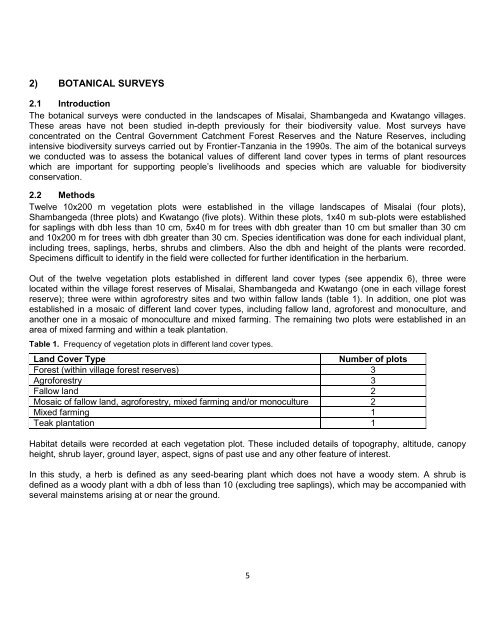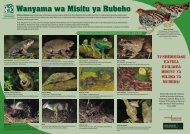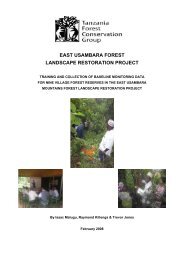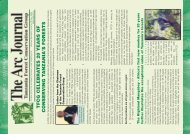Assessment of the biological values of different land cover types in ...
Assessment of the biological values of different land cover types in ...
Assessment of the biological values of different land cover types in ...
You also want an ePaper? Increase the reach of your titles
YUMPU automatically turns print PDFs into web optimized ePapers that Google loves.
2) BOTANICAL SURVEYS<br />
2.1 Introduction<br />
The botanical surveys were conducted <strong>in</strong> <strong>the</strong> <strong>land</strong>scapes <strong>of</strong> Misalai, Shambangeda and Kwatango villages.<br />
These areas have not been studied <strong>in</strong>-depth previously for <strong>the</strong>ir biodiversity value. Most surveys have<br />
concentrated on <strong>the</strong> Central Government Catchment Forest Reserves and <strong>the</strong> Nature Reserves, <strong>in</strong>clud<strong>in</strong>g<br />
<strong>in</strong>tensive biodiversity surveys carried out by Frontier-Tanzania <strong>in</strong> <strong>the</strong> 1990s. The aim <strong>of</strong> <strong>the</strong> botanical surveys<br />
we conducted was to assess <strong>the</strong> botanical <strong>values</strong> <strong>of</strong> <strong>different</strong> <strong>land</strong> <strong>cover</strong> <strong>types</strong> <strong>in</strong> terms <strong>of</strong> plant resources<br />
which are important for support<strong>in</strong>g people‟s livelihoods and species which are valuable for biodiversity<br />
conservation.<br />
2.2 Methods<br />
Twelve 10x200 m vegetation plots were established <strong>in</strong> <strong>the</strong> village <strong>land</strong>scapes <strong>of</strong> Misalai (four plots),<br />
Shambangeda (three plots) and Kwatango (five plots). With<strong>in</strong> <strong>the</strong>se plots, 1x40 m sub-plots were established<br />
for sapl<strong>in</strong>gs with dbh less than 10 cm, 5x40 m for trees with dbh greater than 10 cm but smaller than 30 cm<br />
and 10x200 m for trees with dbh greater than 30 cm. Species identification was done for each <strong>in</strong>dividual plant,<br />
<strong>in</strong>clud<strong>in</strong>g trees, sapl<strong>in</strong>gs, herbs, shrubs and climbers. Also <strong>the</strong> dbh and height <strong>of</strong> <strong>the</strong> plants were recorded.<br />
Specimens difficult to identify <strong>in</strong> <strong>the</strong> field were collected for fur<strong>the</strong>r identification <strong>in</strong> <strong>the</strong> herbarium.<br />
Out <strong>of</strong> <strong>the</strong> twelve vegetation plots established <strong>in</strong> <strong>different</strong> <strong>land</strong> <strong>cover</strong> <strong>types</strong> (see appendix 6), three were<br />
located with<strong>in</strong> <strong>the</strong> village forest reserves <strong>of</strong> Misalai, Shambangeda and Kwatango (one <strong>in</strong> each village forest<br />
reserve); three were with<strong>in</strong> agr<strong>of</strong>orestry sites and two with<strong>in</strong> fallow <strong>land</strong>s (table 1). In addition, one plot was<br />
established <strong>in</strong> a mosaic <strong>of</strong> <strong>different</strong> <strong>land</strong> <strong>cover</strong> <strong>types</strong>, <strong>in</strong>clud<strong>in</strong>g fallow <strong>land</strong>, agr<strong>of</strong>orest and monoculture, and<br />
ano<strong>the</strong>r one <strong>in</strong> a mosaic <strong>of</strong> monoculture and mixed farm<strong>in</strong>g. The rema<strong>in</strong><strong>in</strong>g two plots were established <strong>in</strong> an<br />
area <strong>of</strong> mixed farm<strong>in</strong>g and with<strong>in</strong> a teak plantation.<br />
Table 1. Frequency <strong>of</strong> vegetation plots <strong>in</strong> <strong>different</strong> <strong>land</strong> <strong>cover</strong> <strong>types</strong>.<br />
Land Cover Type Number <strong>of</strong> plots<br />
Forest (with<strong>in</strong> village forest reserves) 3<br />
Agr<strong>of</strong>orestry 3<br />
Fallow <strong>land</strong> 2<br />
Mosaic <strong>of</strong> fallow <strong>land</strong>, agr<strong>of</strong>orestry, mixed farm<strong>in</strong>g and/or monoculture 2<br />
Mixed farm<strong>in</strong>g 1<br />
Teak plantation 1<br />
Habitat details were recorded at each vegetation plot. These <strong>in</strong>cluded details <strong>of</strong> topography, altitude, canopy<br />
height, shrub layer, ground layer, aspect, signs <strong>of</strong> past use and any o<strong>the</strong>r feature <strong>of</strong> <strong>in</strong>terest.<br />
In this study, a herb is def<strong>in</strong>ed as any seed-bear<strong>in</strong>g plant which does not have a woody stem. A shrub is<br />
def<strong>in</strong>ed as a woody plant with a dbh <strong>of</strong> less than 10 (exclud<strong>in</strong>g tree sapl<strong>in</strong>gs), which may be accompanied with<br />
several ma<strong>in</strong>stems aris<strong>in</strong>g at or near <strong>the</strong> ground.<br />
5






